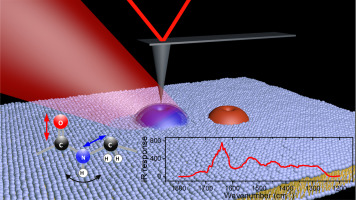当前位置:
X-MOL 学术
›
BBA Bioenerg.
›
论文详情
Our official English website, www.x-mol.net, welcomes your feedback! (Note: you will need to create a separate account there.)
The role of xanthophylls in the supramolecular organization of the photosynthetic complex LHCII in lipid membranes studied by high-resolution imaging and nanospectroscopy.
Biochimica et Biophysica Acta (BBA) - Bioenergetics ( IF 4.3 ) Pub Date : 2019-11-14 , DOI: 10.1016/j.bbabio.2019.148117 Jiangtao Zhou 1 , Sergey Sekatskii 1 , Renata Welc 2 , Giovanni Dietler 1 , Wieslaw I Gruszecki 2
Biochimica et Biophysica Acta (BBA) - Bioenergetics ( IF 4.3 ) Pub Date : 2019-11-14 , DOI: 10.1016/j.bbabio.2019.148117 Jiangtao Zhou 1 , Sergey Sekatskii 1 , Renata Welc 2 , Giovanni Dietler 1 , Wieslaw I Gruszecki 2
Affiliation

|
The xanthophyll cycle is a regulatory mechanism operating in the photosynthetic apparatus of plants. It consists of the conversion of the xanthophyll pigment violaxanthin to zeaxanthin, and vice versa, in response to light intensity. According to the current understanding, one of the modes of regulatory activity of the cycle is associated with the influence on a molecular organization of pigment-protein complexes. In the present work, we analyzed the effect of violaxanthin and zeaxanthin on the molecular organization of the LHCII complex, in the environment of membranes formed with chloroplast lipids. Nanoscale imaging based on atomic force microscopy (AFM) showed that the presence of exogenous xanthophylls promotes the formation of the protein supramolecular structures. Nanoscale infrared (IR) absorption analysis based on AFM-IR nanospectroscopy suggests that zeaxanthin promotes the formation of LHCII supramolecular structures by forming inter-molecular β-structures. Meanwhile, the molecules of violaxanthin act as "molecular spacers" preventing self-aggregation of the protein, potentially leading to uncontrolled dissipation of excitation energy in the complex. This latter mechanism was demonstrated with the application of fluorescence lifetime imaging microscopy. The intensity-averaged chlorophyll a fluorescence lifetime determined in the LHCII samples without exogenous xanthophylls at the level of 0.72 ns was longer in the samples containing exogenous violaxanthin (2.14 ns), but shorter under the presence of zeaxanthin (0.49 ns) thus suggesting a role of this xanthophyll in promotion of the formation of structures characterized by effective excitation quenching. This mechanism can be considered as a representation of the overall photoprotective activity of the xanthophyll cycle.
中文翻译:

叶黄素在脂膜中光合复合物LHCII的超分子组织中的作用通过高分辨率成像和纳米光谱研究。
叶黄素循环是一种在植物的光合作用中起作用的调节机制。它包括根据光强度将叶黄素色素紫黄质转化为玉米黄质,反之亦然。根据目前的理解,循环的调节活性模式之一与对色素-蛋白质复合物的分子组织的影响有关。在目前的工作中,我们分析了在叶绿体脂质形成的膜环境中,紫黄质和玉米黄质对LHCII复合物分子结构的影响。基于原子力显微镜(AFM)的纳米级成像显示,外源叶黄素的存在促进了蛋白质超分子结构的形成。基于AFM-IR纳米光谱的纳米级红外(IR)吸收分析表明,玉米黄质通过形成分子间β结构来促进LHCII超分子结构的形成。同时,紫黄质的分子充当“分子间隔子”,阻止蛋白质的自聚集,潜在地导致复合物中激发能的不受控制的耗散。通过荧光寿命成像显微镜的应用证明了后一种机理。在不含外源叶黄素的LHCII样品中,在0.72 ns的水平下测定的强度平均叶绿素a荧光寿命在含有外源紫黄质的样品中(2.14 ns)更长,但在玉米黄质的存在下则较短(0。49 ns),因此表明该叶黄素在促进以有效激发猝灭为特征的结构形成中的作用。该机制可以认为是叶黄素循环总体光保护活性的代表。
更新日期:2019-11-14
中文翻译:

叶黄素在脂膜中光合复合物LHCII的超分子组织中的作用通过高分辨率成像和纳米光谱研究。
叶黄素循环是一种在植物的光合作用中起作用的调节机制。它包括根据光强度将叶黄素色素紫黄质转化为玉米黄质,反之亦然。根据目前的理解,循环的调节活性模式之一与对色素-蛋白质复合物的分子组织的影响有关。在目前的工作中,我们分析了在叶绿体脂质形成的膜环境中,紫黄质和玉米黄质对LHCII复合物分子结构的影响。基于原子力显微镜(AFM)的纳米级成像显示,外源叶黄素的存在促进了蛋白质超分子结构的形成。基于AFM-IR纳米光谱的纳米级红外(IR)吸收分析表明,玉米黄质通过形成分子间β结构来促进LHCII超分子结构的形成。同时,紫黄质的分子充当“分子间隔子”,阻止蛋白质的自聚集,潜在地导致复合物中激发能的不受控制的耗散。通过荧光寿命成像显微镜的应用证明了后一种机理。在不含外源叶黄素的LHCII样品中,在0.72 ns的水平下测定的强度平均叶绿素a荧光寿命在含有外源紫黄质的样品中(2.14 ns)更长,但在玉米黄质的存在下则较短(0。49 ns),因此表明该叶黄素在促进以有效激发猝灭为特征的结构形成中的作用。该机制可以认为是叶黄素循环总体光保护活性的代表。


























 京公网安备 11010802027423号
京公网安备 11010802027423号